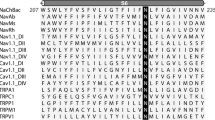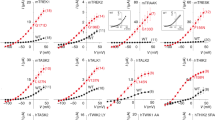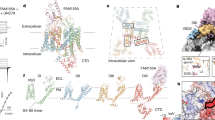Abstract
The pore of sodium channels contains a selectivity filter made of 4 amino acids, D/E/K/A. In voltage sensitive sodium channel (Nav) channels from jellyfish to human the fourth amino acid is Ala. This Ala, when mutated to Asp, promotes slow inactivation. In some Nav channels of pufferfishes, the Ala is replaced with Gly. We studied the biophysical properties of an Ala-to-Gly substitution (A1529G) in rat Nav1.4 channel expressed in Xenopus oocytes alone or with a β1 subunit. The Ala-to-Gly substitution does not affect monovalent cation selectivity and positively shifts the voltage-dependent inactivation curve, although co-expression with a β1 subunit eliminates the difference between A1529G and WT. There is almost no difference in channel fast inactivation, but the β1 subunit accelerates WT current inactivation significantly more than it does the A1529G channels. The Ala-to-Gly substitution mainly influences the rate of recovery from slow inactivation. Again, the β1 subunit is less effective on speeding recovery of A1529G than the WT. We searched Nav channels in numerous databases and noted at least four other independent Ala-to-Gly substitutions in Nav channels in teleost fishes. Thus, the Ala-to-Gly substitution occurs more frequently than previously realized, possibly under selection for alterations of channel gating.







Similar content being viewed by others
References
Balser JR, Nuss HB, Chiamvimonvat N, Perez-Garcia MT, Marban E, Tomaselli GF (1996) External pore residue mediates slow inactivation in µ1 rat skeletal muscle sodium channels. J Physiol (Lond) 494:431–442
Cannon SC, McClatchey A, Gusella JF (1993) Modification of the Na+ current conducted by the rat skeletal muscle a subunit by co expression with a human brain β subunit. Pflugers Arch 423:155–157
Catterall WA, Glodin AL, Waxman SG (2005) International Union of Pharmacology, XLVII. Nomenclature and structure-function relationships of voltage-gated sodium channels. Pharmacol Rev 57:397–409
Chang SY, Satin J, Fozzard HA (1996) Modal behavior of the mu 1 Na+ channel and effects of coexpression of the beta 1-subunit. Biophys J 70:2581–2592
Colquhoun D, Hawkes AG (1977) Relaxation and fluctuations of membrane currents that flow through drug-operated channels. Proc R Soc London Ser B 199:231–262
Cormier JW, Rivolta I, Tateyama M, Yang AS, Kass RS (2002) Secondary structure of the human cardiac Na+ channel C terminus. J Biol Chem 277:9233–9241
Cronin J, O’Malley RE (1999) Analyzing multiscale phenomena using singular perturbation methods: American Mathematical Society short course, Jan 5–6, 1998. In: Proceedings of symposia in applied mathematics, vol 56. Baltimore, MD
Cummins TR, Sigworth FJ (1996) Impaired slow inactivation in mutant Na channels. Biophy J 71:227–236
Dale RP, Jones AK, Tamborindeguy C, Davies TG, Amey JS, Williamson S, Wolstenholme A, Field LM, Williamson MS, Walsh TK, Sattelle DB (2010) Identification of ion channel genes in the Acyrthosiphon pisum genome. Insect Mol Biol 19(2):141–153
Destexhe A, Huguenard J (2001) Which formalism to use for modeling voltage-dependent conductances. In: De Schutter E (ed) Computational Neuroscience: Realistic Modeling for Experimentalists. CRC Press, Boca Raton, pp 129–158
Heinemann SH, Terlau W, Stuhmer W, Imoto K, Numa S (1992) Calcium channel characteristics conferred on the sodium channel by single mutations. Nature (Lond) 356:441–443
Hilber K, Sandtner W, Kudlacek O, Glasser IW, Weisz E, Kyle JW, French RJ, Fozzard HA, Dudley SC, Todt H (2001) The selectivity filter of the voltage-gated Na channel is involved in channel activation. J Biol Chem 276:27831–27839
Hilber K, Sandtner W, Kudlacek O, Schreiner B, Glasser I, Schutz W, Fozzard HA, Dudley SC, Todt H (2002) Interaction between fast and ultra-slow inactivation in the voltage-gated Na channel. Does the inactivation gate stabilize the channel structure? J Biol Chem 277:37105–37115
Hille B (1972) The permeability of the sodium channel to metal cations in myelinated nerve. J Gen Physiol 59:637–658
Hille B (1992) Ionic channels of excitable membranes, 2nd edn. Sinauer Associates, Inc., Sunderland, MA
Hodgkin AL, Huxley AF (1952) A quantitative description of membrane current and its application to conduction and excitation in nerve. J Physiol (London) 117:500–544
Huth T, Schmidtmayer J, Alzheimer C, Hansen UP (2008) Four-mode gating model of fast inactivation of sodium channel Nav1.2a. Pflugers Arch 457:103–119
Isom LL, De-Jongh KS, Patton DE, Reber BF, Offord J, Charbonneau H, Walsh K, Goldin AL, Catterall WA (1992) Primary structure and functional expression of the β subunit of the rat brain sodium channel. Science 256:839–842
Jang J, Yotsu-Yamashita M (2006) Distribution of tetrodotoxin, saxitoxin, and their analogs among tissues of the puffer fish Fugu pardalis. Toxicon 48:980–987
Jost MC, Hillis DM, Lu Y, Kyle JW, Fozzard HA, Zakon HH (2008) Toxin-resistant sodium channels: parallel adaptive evolution across a complete gene family. Mol Biol Evol 25:1016–1024
Kambouris NG, Hastings LA, Stepanovic S, Marban E, Tomaselli GF, Balser JR (1998) Mechanistic link between lidocaine block and inactivation probed by outer pore mutations in the rat micro 1 skeletal muscle Na channel. J physiol 512:693–705
Liebeskind BJ, Hillis DM, Zakon HH (2011) Evolution of sodium channels predates the origin of nervous systems in animals. Proc Natl Acad Sci USA 108:9154–9159
Lipkind FM, Fozzard HA (2008) Voltage-gated Na channel selectivity: the role of the conserved domain III lysine residue. J Gen Physiol 131:523–529
Makita N, Bennett PB, George AL Jr (1996) Molecular determinants of β1 subunit-induced gating modulation in voltage-dependent Na+ channels. J Neurosci 16(22):7117–7127
Mantegazza M, Yu FH, Catterall WA, Scheuer T (2001) Role of the C-terminal domain in inactivation of brain and cardiac sodium channels. Proc Natl Acad Sci USA 98:15348–15353
Marom S, Abbott LF (1994) Modeling state-dependent inactivation of membrane currents. Biophys J 67:515–520
Nakashima K, Arakawa O, Taniyama S, Nonaka M, Takatani T, Yamamori K, Fuchi Y, Noguchi T (2004) Occurrence of saxitoxins as a major toxin in the ovary of a marine puffer Arothron firmamentum. Toxicon 43:207–212
Novak AE, Jost MC, Lu Y, Taylor AD, Zakon HH, Ribera AB (2006) Gene duplications and evolution of vertebrate voltage-gated sodium channels. J Mol Evol 63:208–221
Nuss HB, Chiamvimonvat N, Perez-Garcia MT, Tomaselli GF, Marban E (1995) Functional association of the β1 subunit with human cardiac (hH1) and rat skeletal muscle (µ1) sodium channel α subunits expressed in Xenopus oocytes. J Gen Physiol 106:1171–1191
Ong BH, Tomaselli GF, Balser JR (2000) A structural rearrangement in the sodium channel pore linked to slow inactivation and use dependence. J Gen Physiol 116:653–662
Patlak J (1991) Molecular kinetics of voltage-dependent Na+ channels. Physiol Rev 71:1047–1080
Patton DE, Isom LL, Catterall WA, Goldin AL (1994) The adult rat brain β1 subunit modifies activation and inactivation gating of multiple sodium channel α subunits. J Biol Chem 269:17649–17655
Schlief T, Schoenherr R, Imoto K, Heinemann SH (1996) Pore properties of rat brain II sodium channels mutated in the selectivity filter domain. Eur Biophys J 25:75–91
Tateyama M, Rivolta I, Clancy CE, Kass RS (2003) Modulation of cardiac sodium channel gating by protein kinase A can be altered by disease-linked mutation. J Biol Chemtat 278:46718–46726
Terlau H, Heinemann SH, Stuhmer W, Pusch M, Conti F, Imoto K, Numa S (1991) Mapping the site of block by tetrodotoxin and saxitoxin of sodium channel II. FEBS Lett 293:93–96
Tikhonov DB, Zhorov BS (2007) Sodium channels: ionic model of slow inactivation and state-dependent drug binding. Biophys J 93:1557–1570
Todt H, Dudley SC, Kyle JW, French RJ, Fozzard HA (1999) Ultra-slow inactivation in µ1 Na+ channels is produced by a structural rearrangement of the outer vestibule. Biophys J 76:1335–1345
Tomaselli GF, Chiamvimonvat N, Nuss HB, Balser JR, Perez-Garcia MT, Xu RH, Orias DW, Backx PH, Marban E (1995) A mutation in the pore of the Na channel alters gating. Biophys J 68:1814–1827
Tsushima RG, Li RA, Backx PH (1997) Altered ionic selectivity of the Na channel revealed by cysteine mutations within the pore. J Gen Physiol 109:463–475
Wang SY, Wang GK (1996) Slow inactivation of muscle µ1 Na+ channels in permanently transfected mammalian cells. Pflugers Arch 432:692–699
Willms AR, Baro DJ, Harris-Warrick RM, Guckenheimer J (1999) An improved parameter estimation method for Hodgkin-Huxley models. J Comput Neurosci 6:145–168
Xiong W, Li RA, Tian Y, Tomaselli GF (2003) Molecular motions of the outer ring of charge of the sodium channel: do they couple to slow inactivation? J Gen Physiol 122:323–332
Xu Q, Wang H, Zhang L, Liu N (2006) Sodium channel gene expression associated with pyrethroid resistant house flies and German cockroaches. Gene 379:62–67
Yang YC, Hsieh JY, Kuo CC (2009) The external pore loop interacts with S6 and S3–S4 linker in domain 4 to assume an essential role in gating control and anticonvulsant action in the Na+ channel. J Gen Physiol 134(2):95–113
Zakon HH, Jost MC, Lu Y (2011) Expansion of voltage-dependent Na+ channel gene family in early tetrapods coincided with the emergence of territoriality and increased brain complexity. Mol Biol Evol 28:1415–1424
Zhou JY, Potts JF, Trimmer JS, Agnew WS, Sigworth FJ (1991) Multiple gating modes and the effect of modulating factors on the micro I sodium channel. Neuron 7:775–785
Zimmer T, Benndorf K (2002) The human heart and rat brain IIA Na+ channels interact with different molecular regions of the β1 subunit. J Gen Physiol 120:887–895
Acknowledgments
This work was supported by National Institutes of Health Grant R01GM084879 and a Wellcome Trust/DBT Early Career fellowship to BS. We thank Drs. Harry Fozzard, Jack Kyle and Alan Goldin for all constructs used in the work. We also thank Dr. Adron Harris for providing the facility for oocyte work.
Author information
Authors and Affiliations
Corresponding author
Rights and permissions
About this article
Cite this article
Wu, M., Ye, N., Sengupta, B. et al. A naturally occurring amino acid substitution in the voltage-dependent sodium channel selectivity filter affects channel gating. J Comp Physiol A 199, 829–842 (2013). https://doi.org/10.1007/s00359-013-0845-3
Received:
Revised:
Accepted:
Published:
Issue Date:
DOI: https://doi.org/10.1007/s00359-013-0845-3




